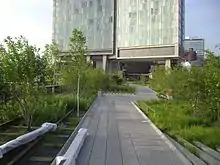Park conservancy
A park conservancy is a type of private, non-profit organization in the United States, that can support the maintenance, capital development, and advocacy for parks or park systems.[1] These organizations raise money through a variety of means to care for urban parks, and while there is not a single model for how a park conservancy can or should be developed, they are created to meet the needs of local communities based on their resources and political situations.[2][3][4]

Park conservancy development
Park conservancies developed in relation to what some call a fifth model for parks, namely those that are sustainable in plantings, usage, and funding.[5] This arose in part due to a lack of public funding allocation for parks, along with structure that allowed the members of the community to directly support their own parks. The number of parks conservancies has grown in the past decades as city funding for parks has in many cases declined, playing an increasingly prominent role in urban parks.[6] One particular aspect of them involves their management, which is independent of local municipal elections. They generally take a long-term perspective on parks, and as a result are financially focused on long-term sustainability to meet their management needs.[7] While the Central Park Conservancy is often considered the first of its kind, they remain different than Friends of the Park groups, Business Improvement Districts (BIDs), and most conservancies in California (where conservancies are often names of state agencies).[6]
Controversies
While park conservancies are increasingly relied upon to manage, fund, and care for urban parks, they are not without controversy. Some claim that their popularity encourages government to step back from their responsibilities to fund public spaces, and the more they give away their authority the less public oversight exists. Along these lines, funding decisions increasingly depend upon fund-raising, leading to potential conflicts with wealthy donors influencing decisions that affect the rights of those who are often poorest and in most need of the parks themselves.[8][9]
Prominent park conservancies
While New York City has the most conservancies of any American city,[10] conservancy management and care of large and small urban parks can be found across the country. One size or approach to developing or using park conservancies will not be the same everywhere based on size or funding,[11] Some of these include:
- Abingdon Square Park, New York, NY
- Balboa Park, San Francisco, CA
- Golden Gate National Parks (GGNRA), San Francisco Bay Area, CA
- Brooklyn Bridge Park, Brooklyn, NY
- Central Park Conservancy, New York, NY
- The High Line, New York, NY
- Forest Park, St. Louis, MO
- Millennium Park, Chicago, IL
- Piedmont Park, Atlanta, GA
- Pittsburgh Parks Conservancy, Pittsburgh, PA
- Overton Park Conservancy Memphis, TN
- Shelby Farms Park Conservancy, Memphis, TN
- Memphis River Parks Partnership, Memphis, TN
References
- "Where to get help in your city: City-wide parks non-profits". Parkology. Retrieved April 26, 2018.
- Public parks, private partners: How partnerships are revitalizing urban parks. ISBN 978-0970632432.
- B., Miller, Lynden (2009). Parks, plants, and people: Beautifying the urban landscape (1st ed.). New York: Norton. ISBN 9780393732030. OCLC 286486235.
- Slavin, Peter (June 10, 2015). "Making Park Conservancies Work". Urban Land Magazine. Retrieved April 26, 2018.
- Cranz, Galen; Boland, Michael (2004-01-01). "Defining the Sustainable Park: A Fifth Model for Urban Parks". Landscape Journal. 23 (2): 102–120. doi:10.3368/lj.23.2.102. ISSN 0277-2426.
- Harnik, Peter; Martin, Abby (2015). Public Spaces/Private Money: The Triumphs and Pitfalls of Urban Park Conservancies (PDF). The Trust for Public Land.
- Protecting the wild: Parks and wilderness, the foundation for conservation. Wuerthner, George,, Crist, Eileen, 1961-, Butler, Tom, 1963-. San Francisco, CA. 2015-02-19. ISBN 9781610915519. OCLC 907538560.CS1 maint: others (link)
- John, Krinsky. Who cleans the park? : public work and urban governance in New York City. Simonet, Maud. Chicago. ISBN 9780226435619. OCLC 979417574.
- Braun, Bruce; Castree, Noel (2005). Remaking Reality: Nature at the Millenium. Routledge. ISBN 1134824998.
- "Partners: NYC Parks". www.nycgovparks.org. Retrieved 2018-02-12.
- Hayward, Phil; Dolesh, Richard J. (October 1, 2013). "Creating a Park Conservancy that Fits". www.nrpa.org. Retrieved 2018-04-29.